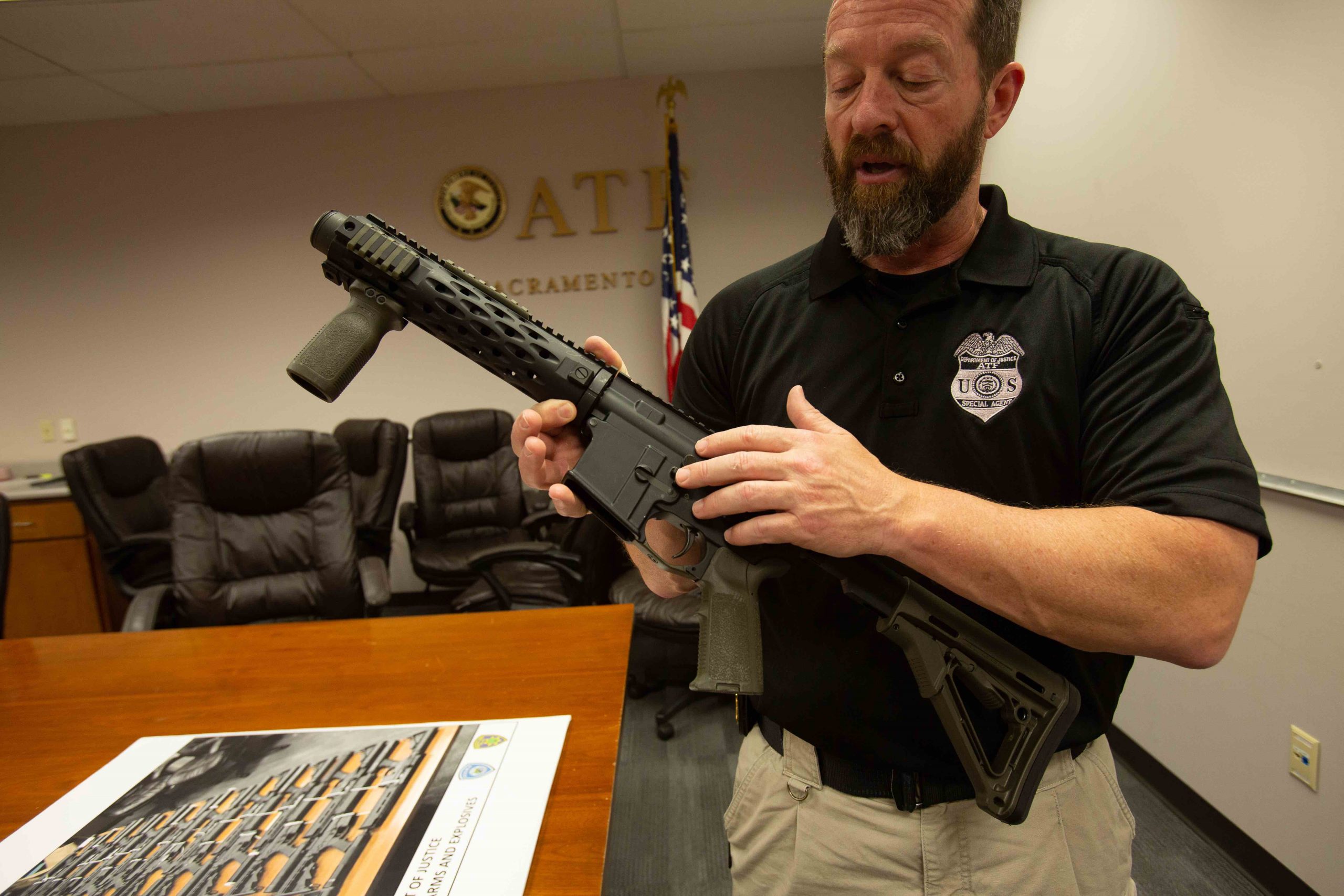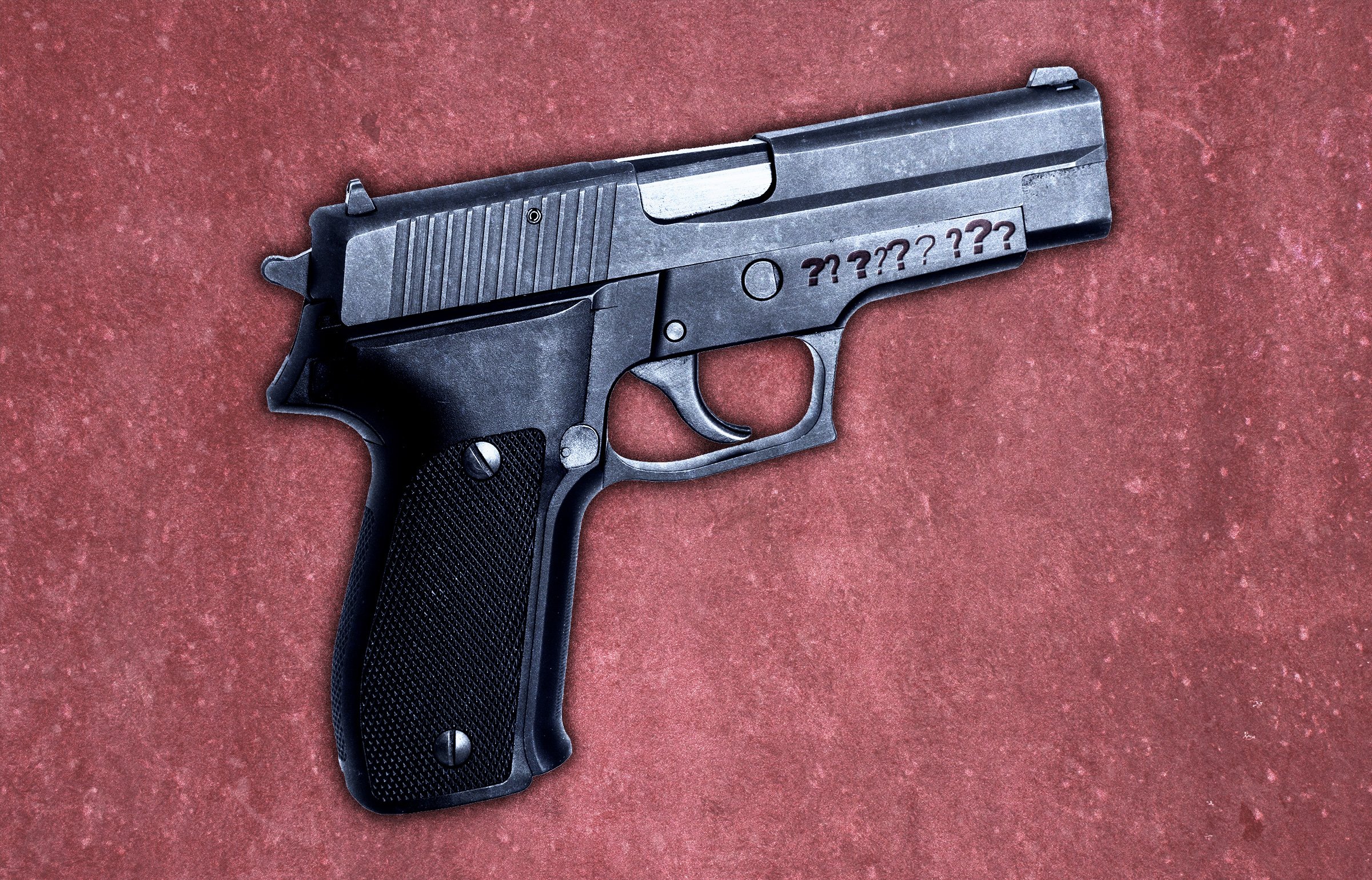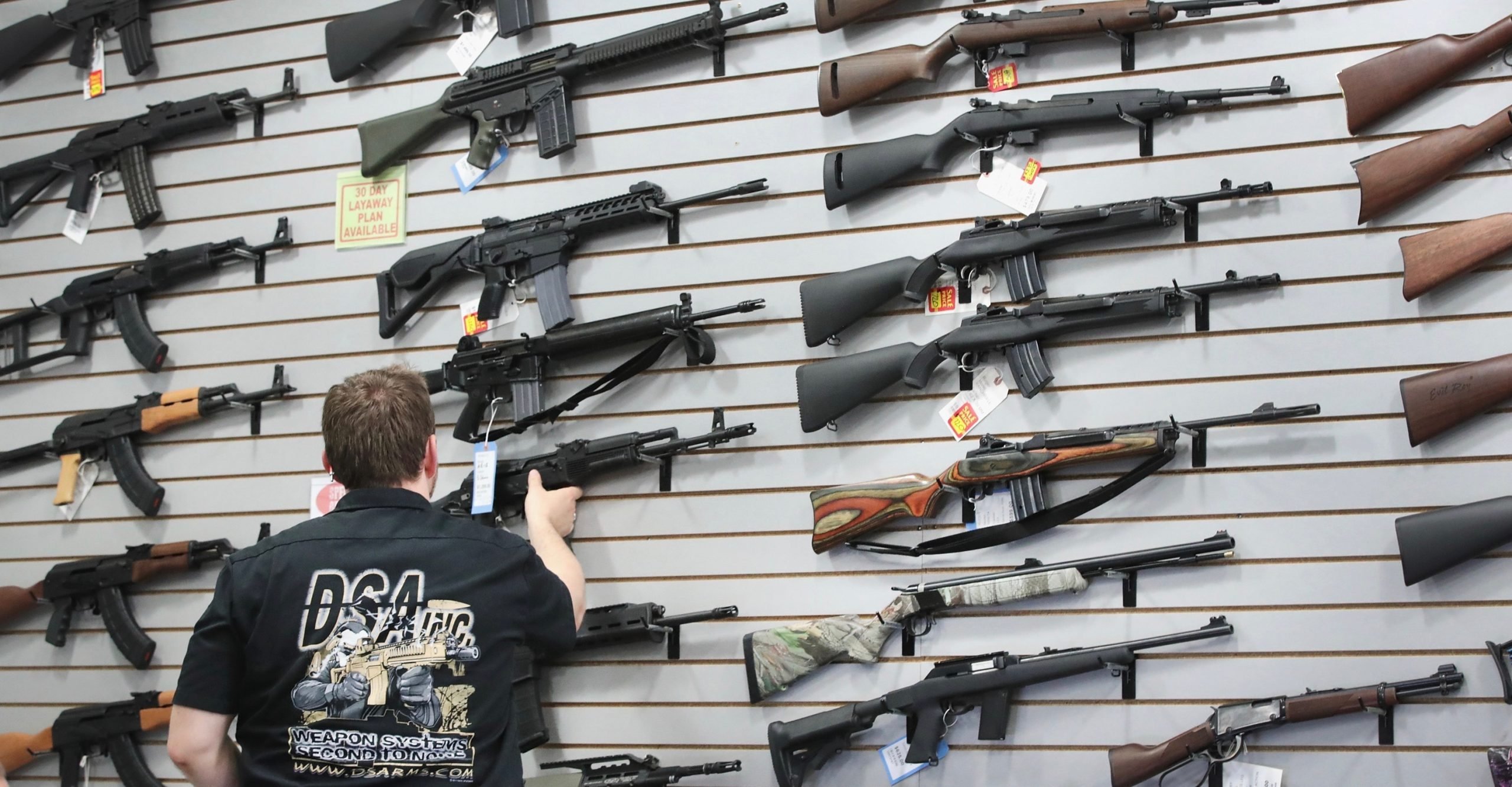For the better part of a year, Kevin Savangsy allegedly sold caches of weapons to federal agents out of parking lots and garages in Sacramento. The 29-year-old told his customers that he could get “hella shit,” including guns that police would never trace.
Court documents suggest he lived up to that promise.
At first, Savangsy’s offerings were conventional: handguns, AK-47s, and AR-15s. Then, on the morning of October 23, 2018, he unveiled his newest product: a homemade, unserialized pistol modeled after a Glock. Over the next three months, agents with the Bureau of Alcohol, Tobacco, Firearms and Explosives bought a dozen more unserialized weapons, including AR-15s modified to shoot fully automatic. A raid on Savangsy’s home in late January turned up thousands of dollars of cash, pounds of drugs, and 24 machine guns.
Unserialized weapons, colloquially known as “ghost guns,” entered the American imagination as the creation of hobbyists and backyard tinkerers. But as they’ve grown in popularity, criminals have identified ghost guns as a way to get around California’s restrictive gun laws. This class of weapons is easy to buy, and undetectable to authorities, because they are built without the government’s knowledge.
An investigation by The Trace in partnership with NBC Bay Area, NBC San Diego, and NBC Los Angeles found that law enforcement agencies across California are recovering record numbers of ghost guns. According to the ATF, 30 percent of all guns now recovered by agents in the state are unserialized. And without a serial number, they cannot be traced in criminal investigations.
California police departments that track ghost gun recoveries are seeing a similar trend. “This is not just something for enthusiasts. This has become something for people that are actual practitioners of violence,” said Graham Barlowe, the resident agent in charge at the ATF’s Sacramento field office.

A ghost gun is a firearm manufactured outside of the traditional supply chain. It can be printed on a 3-D printer, or assembled with parts sold by the dozens of companies that create nearly completed firearms — known as “80 percent receivers,” which require no background check to sell.
California police records show that ghost guns were recovered in homicides, robberies, active shooter incidents, and domestic violence cases. In July 2014, bank robbers in Stockton took three hostages on a high-speed chase with police. The rolling gun battle ended with one hostage and two suspects killed. Police recovered a homemade AK-47 at the scene. A year later, a 21-year-old man shot and killed a 19-year-old woman before killing himself at his home in Walnut Creek. The former Stanford engineering student had assembled pieces purchased online into a working gun.
In several cases reviewed in detail by The Trace and NBC, perpetrators specifically sought out ghost guns because they knew they would fail a background check. In 2013, John Zawahari assembled an unserialized AR-15 after failing a screening at a gun store. He used the weapon to kill five people on a college campus in Santa Monica. Four years later, in 2017, Kevin Neal, a 44-year-old cannabis farmer with a criminal record barring him from gun ownership, went online and purchased the parts to build an AR-15. In a 25-minute shooting spree across Tehama County, he killed five people and injured 18 more.

Experts say the accessibility of ghost guns is aided by a cottage industry of retailers selling nearly completed firearms that require no screening to purchase.
As ghost guns proliferate across the state, lawmakers and police are scrambling to understand the scale of the problem, let alone remedy it. In 2016, the California Legislature passed a law requiring residents to register homemade weapons with law enforcement. A separate requirement outlawed the possession of unregistered ghost guns.
But records obtained by The Trace and NBC indicate that the law has had little effect. Compliance with the law is low, and prosecutors have never brought charges under the new statute.
Now California law enforcement members are encountering ghost guns being made by criminals building them in their basement, as well as organized groups churning out untraceable firepower by the hundreds. “We’ve seen machine shops where they are lining them up and and completing them in 20-minute intervals, with three or four machines going at once,” said Barlowe, the ATF agent in Sacramento.
The majority of America’s guns begin their life with a stream of paperwork mandated by the federal government. These weapons, each with a unique serial number, enter the civilian market through licensed firearms dealers, which require background checks. Over time, every additional sale is recorded, providing a log of a gun’s life that can be a little tricky to piece together, but an absolutely critical tool to criminal investigations.
A ghost gun subverts this system entirely — because it doesn’t automatically get stamped with a serial number, isn’t sold by a federally licensed dealer, and doesn’t generate paperwork.
Federal law permits the creation of firearms for personal use. Homemade weapons have long been treasured by gunsmiths and hobbyists seeking a firearm to meet their precise specifications. After the mass shooting at Sandy Hook Elementary School, however, that changed. Fearing increased gun controls, some activists identified ghost guns as a means to create and own the weapons that some Democratic lawmakers wanted to regulate.
That charge was lead by Cody Wilson, a gun rights activist who lives in Austin, Texas. His company, Defense Distributed, made headlines by publishing online schematics to produce nearly completed guns on 3D printers. With a few additional parts purchased from a gun store, anyone could make their own firearm. “It’s very, very cheap now to make these things for yourself, just because of where we are with the state of technology,” Wilson, who is currently facing charges of sexually assaulting a minor, told The Trace in 2015.
Several companies picked up on the trend, selling what are known as “80 percent lower receivers.” In layman’s terms, a receiver is a gun’s spine, akin to the chassis of a car or the foundation of a building. Once a lower receiver is “complete,” it is legally a firearm, and requires a background check to sell. But in the eyes of the government, an 80 percent lower is nothing more than a hunk of metal, even though it can easily be fashioned into a completed firearm. “If you can put Ikea furniture together, you can make one of these,” said Carlos Canino, the Special Agent in Charge of the ATF’s Los Angeles Division. “They could make one thousand or ten thousand of these. Nobody would know.”

It’s this anonymity that makes ghost guns attractive, and valuable, to criminals. According to Barlowe, the going rate for a completed ghost gun on the black market is between $1,500 and $2,000. (For comparison, the going rate for a store-bought AR-15 is around $500.)
“Most people are looking to double their money on their investment. However, we are seeing in some cases they’re they’re quadrupling their money.” he said.
Many gun rights advocates have dismissed fears by law enforcement that ghost guns pose an acute threat to public safety.
Rick Vasquez, the former head of the ATF’s Firearms Technology Division, disagrees. He’s seen ghost guns, pieced together with parts originating in the United States, recovered by law enforcement in countries as far away as Brazil and Australia. “It’s so common, it’s absolutely everywhere,” he said.
On the night of June 28, 2018, police and firefighters in San Diego responded to a domestic disturbance at a condo in the College Area neighborhood. After 20 minutes of knocking on the door, the officers started smelling and seeing smoke.
Bodycam footage, released on May 13 by the San Diego County District Attorney’s Office, shows a firefighter pry open the door. Within seconds, the building’s hallway explodes with gunfire. An officer falls backward to the floor, struck by a rifle round. “I can’t move!” he cries.
Officers scramble to return fire at the suspect, identified as 28-year-old Joe Darwish after he was found dead from a self-inflicted gunshot wound. In a report from the prosecutor’s office, one officer noted that, during the confrontation, Darwish seemed to be tracing the officers’ movements, punching round after round through the condo’s wall to get at them. The officer shot in the incident survived his wounds.
Police found in Darwish’s possession a rifle and pistol — both homemade and unserialized. The Trace and NBC confirmed with the San Diego County District Attorney that Darwish was prohibited from owning firearms because of his criminal record.
San Diego’s is one of several California police departments that reports startling increases in ghost gun recoveries. In 2017, officers recovered just five ghost guns in criminal investigations. The following year, recoveries ballooned to 52 — a 940 percent increase.
“It did definitely catch me by surprise” recalled Toniann Rebick, a criminalist with the San Diego Police Department, of the first ghost gun that came across her desk. “Then a few weeks later, I had another one. All of a sudden these are common.”
The Trace and NBC requested ghost gun seizure data from more than a dozen law enforcement agencies across California. The majority of departments, including Los Angeles and Chula Vista, said they do not track recoveries of unserialized weapons at all. The departments that do keep tabs on unserialized weapons reported marked increases. In Oceanside, police recovered 19 ghost guns in 2018, a 280 percent increase over the previous year. In San Jose, which doesn’t separate ghost guns from other firearms without serial numbers, like antique weapons, saw recoveries increase 51 percent during the same period.

“We work so hard in ensuring that individuals pass background checks and are responsible gun owners,” said Eddie Garcia, the chief of the San Jose Police Department. “And that really gets thrown out the door when you have individuals that can just make a homemade gun.”
State law enforcement sources say that because of a lack of funding and training, plus dated software, police are ill-equipped to track recovered ghost guns, and that the process is laborious and confusing.
Tracking ghost guns isn’t just a problem at the local level. Congressional and ATF sources told The Trace and NBC that the bureau does not document recoveries on a national scale. Spokespeople for ATF field divisions in Los Angeles and Sacramento said that approximately 30 percent of all recoveries made by agents are unserialized weapons. The ATF declined The Trace’s request to provide a number of weapons recovered, but did say that ghost guns have become a high priority in criminal investigations.
“Whenever you want to affect change the first thing is measure. Measure the issue and then come up with solutions from that,” said Barlowe. “We’re still at Step One.”
In 2016, California lawmakers passed a bill requiring residents who make their own weapons to register them with state authorities. Any person caught with an unregistered, unserialized weapon would face criminal charges.
The bill’s author, Assemblymember Jim Cooper, a former sheriff’s deputy, described the legislation as a “clear message that the State of California will not sit idly by while innocent people are being killed.”
But records obtained by The Trace and NBC show that the law has had little effect. Since July 2018, only 2,214 ghost guns have been registered in accordance with the law, according to the California Department of Justice. That number is a drop in the bucket compared to the 4.2 million Californians who are believed to own at least one firearm.
Furthermore, not a single person has been charged with having an unregistered ghost gun since the criminal penalties kicked in on January 2019.
State law enforcement officials told the Trace and NBC that the law is a low priority for prosecutors and police. Assemblymember Mike Gipson, whose district includes the city of Compton and the Watts neighborhood of Los Angeles, two of California’s most violent areas, conceded that the law lacks teeth, added that the current law is entirely based on an “honor system.”
Earlier this year, Gipson proposed a new bill, AB 879, which would require background checks to purchase certain gun parts, including 80 percent lower receivers. He says the paper trail will provide an investigative resource for law enforcement if a ghost gun falls into the wrong hands.
For Dimitri Karras, ghost guns were a business opportunity. In 2010, the former Marine founded Ares Armor, a gun parts store in the city of Oceanside. Karras stocked up on 80 percent lowers, and other parts required to complete homemade firearms.
“The idea was to get as many people interested in participating in it as possible, to give it some legitimacy,” said Karras.
Ares Armor was one of the dozens of companies founded in recent years to cater to customers wishing to build their own guns. Because the parts they sell are legal, they operate in broad daylight, along with online retailers occupying domain names like ghostguns.com and ghostrifles.com.

These businesses pose a unique challenge to law enforcement. The ATF also wears the hat of industry watchdog, tasked with monitoring products, manufacturers, and retailers.
In 2014, the agency started carefully observing businesses like Ares Armor to see if their products crossed the line from part to firearm, which would require Karras to obtain a federal license to sell guns and and complete a background check with every sale.
The ATF decided that Ares Armor had crossed the line, and raided the stores. Two dozen agents seized 6,000 incomplete receivers, and a list of 5,000 customers. Prosecutors accused Ares Armor of selling AR-15 receivers that passed a thin technical threshold making them “firearms”.
But after a series of court battles, and with agency never having officially charged Karras, the ATF gave the gun parts back — parts that Karras would later go on to sell. “They did absolutely nothing about it,” he said. “Because at the end of the day, they know they’re wrong.”
The ATF declined to comment on the case.
In 2014, Polymer80, one of the nation’s larger producers of 80 percent receivers, was also raided. The case was dropped.
ATF sources told The Trace that the U.S. Attorney’s Office dropped the case because of fears that a courtroom loss would create a bad legal precedent.

The office declined to comment on that, but a spokesperson, Lauren Horwood, said its methods for dealing with ghost guns are constantly evolving. “Unserialized AR-15-style firearm prosecutions, like other prosecutions, must adapt to new technology and new attempts to evade the law,” she said.
In the years since, federal law enforcement has moved away from going after manufacturers and storefronts — and now focus on known criminal elements seeking out ghost guns.
EP Armory and Polymer80 continue their business. Karras, who now works at another gun parts store, also continues to sell ghost gun parts on the legal market.
What happens in California doesn’t occur in a vacuum. Ghost guns are now spreading across the United States.
“I see this as a wave that started in California and is going to move east,” said Steve Lindley, the former head of the Bureau of Firearms at the California Department of Justice, who now works at the Brady Campaign to Prevent Gun Violence.
Lindley concludes that with political sentiment moving toward tougher gun control measures, more gun buyers across the country will go underground. “Even though you can buy an assault weapon in Minnesota or Texas — why not buy one that the government doesn’t know anything about?”
In a scramble to curtail the trend outside of California, lawmakers from other states have rushed to implement legislation to regulate the homemade gun market.
In 2019 alone, legislators in Washington, Oregon, Connecticut, New York, and Maryland have introduced bills to regulate ghost guns. At the federal level, House Bill 1266, known as the “Ghost Guns are Guns Act” was introduced in February. The bill’s author, Representative Adriana Espilliat, a Democrat from New York, wrote that the proposal could close “the ghost gun loophole.”
While lawmakers debate how to close the loophole, criminals across the country seek to exploit it.
In February, a Texas man was sentenced to eight years in prison after he was found test-firing a 3D-printed gun in the woods. The man was legally barred from buying guns, and after failing to purchase one from a gun store, built his own. He had a hit list of lawmakers.
In April, a teenager in suburban Chicago arrested a college student with suspected ties to white supremacist groups. The teenager had five homemade rifles in various stages of development.
And in Denver, late last year, as a testament to advancing knowledge of federal gun laws by criminals, two men, one of them a Sureno 13 gang member, were busted for allegedly trying to sell over a dozen homemade rifles and a number of silencers to undercover ATF agents.
According to court documents, when the agents asked the arms dealers about their guns, one of the traffickers extolled the virtues of the unserialized weapons before saying that law enforcement would be none the wiser to their exploits because the law, or lack thereof, was on their side.
“You just have to tell ‘em that you build ‘em,” he said.
Additional reporting by Alex Yablon.

